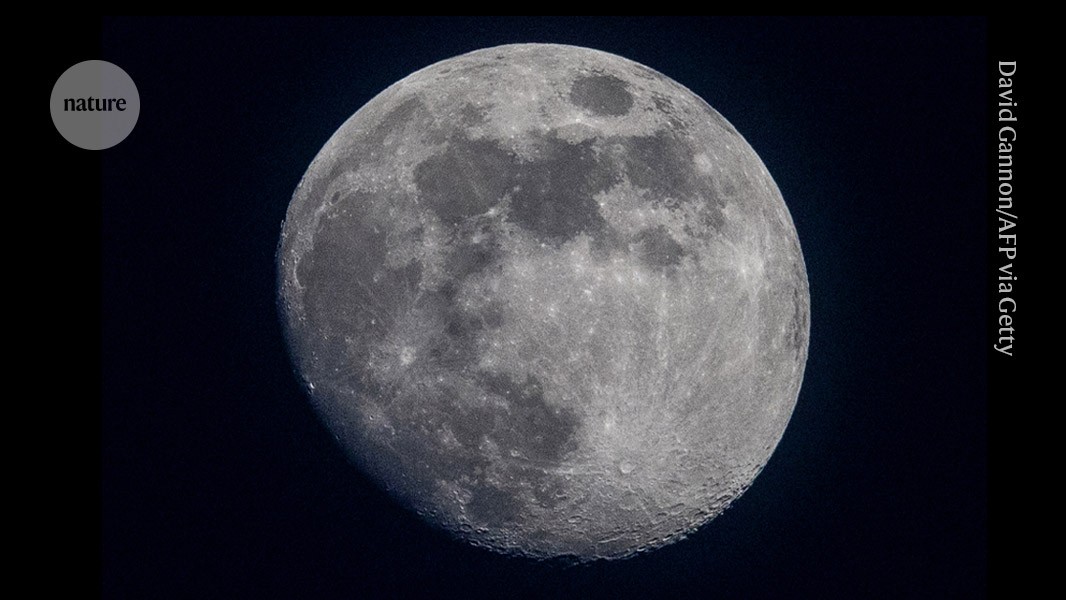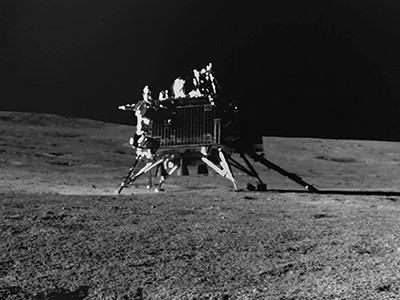
The Moon probably originated from material scattered into space when a large impactor struck the newly formed Earth.Credit: David Gannon/AFP via Getty
India’s Chandrayaan-3 mission has obtained the first measurements of the composition of the soil near the Moon’s south pole1. The minerals found offer further evidence that the lunar surface was entirely molten shortly after the Moon formed.
Chandrayaan-3’s Vikram lander touched down on 23 August 2023. It released a rover called Pragyan, which collected data ranging from temperature to seismological measurements over 10 days.
India’s Moon mission: four things Chandrayaan-3 has taught scientists
Pragyan also studied the chemical composition of the regolith: the fine material that covers much of the lunar surface. The rover stopped and deployed an instrument called an alpha-particle X-ray spectrometer (APXS) 23 times.
Santosh Vadawale, an X-ray astronomer at the Physical Research Laboratory in Ahmedabad, India, and his colleagues analysed radiation data collected by the APXS, and used this information to identify the elements in the regolith and their relative abundances, which, in turn, revealed the soil’s mineral composition. The team found that all 23 samples comprised mainly ferroan anorthosite, a mineral that is common on the Moon. The results were reported in Nature today.
“It’s sort of what we expected to be there based on orbital data, but the ground truth is always really good to get,” says Lindy Elkins-Tanton, a planetary scientist at Arizona State University in Tempe.
Previous landers obtained similar results. However, the Chandrayaan-3 samples are the first from the subpolar region: previous landers visited equatorial and mid-latitude zones. Together, this suggests that the composition of the regolith is uniform across the Moon’s surface.
Vadawale says that this is direct confirmation that the lunar surface was a molten magma ocean immediately after it formed. The lunar magma ocean theory was first proposed by two independent groups in 1970, after rock collected during the 1969 Apollo 11 landing was analysed.
Moon’s origin
The best model for the origin of the Moon is that the newly formed Earth was struck by a large impactor, called Theia, which vaporized the planet’s surface and blasted a large amount of material into orbit. The scattered material swiftly accreted to form the Moon. This impact theory explains why lunar rocks have an isotope composition similar to those on Earth.
The material that formed the Moon had a lot of energy, which had to be dissipated. It escaped in the form of heat and, as a result, the young Moon’s surface melted into a magma ocean. Dense mafic rocks, rich in metals such as magnesium, sank into the Moon’s interior. Lighter rocks, including anorthosite, floated to the top, forming highlands similar to those visited by Chandrayaan-3.
“It gives more support to the lunar magma ocean hypothesis,” says Mahesh Anand, a planetary scientist at the Open University in Milton Keynes, UK.
Vadawale and his colleagues found that their samples contained elevated levels of magnesium compared with those of calcium. This suggests that deeper mafic material has been mixed into the regolith.
The researchers attribute this to the events that formed a huge crater called the South Pole–Aitken basin, the rim of which is 350 kilometres from Chandrayaan-3’s landing site. “When such a large impact basin forms, it is supposed to excavate some deeper material,” says Vadawale, because the impactor drives deep into the crust. This deeper, magnesium-rich material would have been scattered over a huge area, slightly altering the make-up of the regolith Pragyan sampled.
But one problem with that idea is that the South Pole–Aitken basin seems to be dominated by a mineral called pyroxene, which doesn’t quite fit Pragyan’s data, says Anand. Resolving this will probably require samples to be brought back to Earth, he says.
The next Chandrayaan mission, which is in an early phase of development, intends to do just that.
“To me, it’s a story about the success of the Indian space programme,” says Elkins-Tanton.



